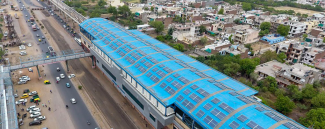The importance of sustainability in transport infrastructure
Transportation infrastructure is fundamental for economic development. And with increasing air pollution and vehicular traffic, sustainable infrastructure has become a necessity for cities to thrive. Building sustainable infrastructure creates the future for next generation. Sustainable transport is one area of infrastructure that focuses on sustainability during implementation, building vibrant communities, reducing material use, reducing energy consumption and thereby reducing environmental impacts. In India, transportation infrastructure is particularly important to improve upon as the country prepares for a more sustainable, reliable and resilient future.

Redefining Delhi Metro through sustainable power transformation
The Delhi Metro is a mass rapid transit (MRT) system serving Delhi and its satellite cities of Ghaziabad, Faridabad, Gurugram, Noida, Bahadurgarh and Ballabhgarh, in the National Capital Region of India. With a vast network of 12 lines and 285 stations spread over 389 km, the DMRC (Delhi Metro Rail Corporation) is the fifth largest metro system in the world. In order to provide the best possible service for commuters, DMRC leadership committed to creating the most resilient and efficient system possible.
First, DMRC pursued and achieved the LEED certification for their metro stations. From this point, they further committed to pursuing PEER certification across their portfolio of lines and stations to benchmark and evaluate their power system performance, with the single objective of providing quality service to its commuters. To date, DMRC has achieved PEER certification for Line 2 (Yellow line), 3 (Blue line), 4 (Blue line), 5 (Green line) and 6 (Violet line). Several other metro lines are pursuing PEER certification to measure the reliability, resilience, safety, and efficiency of their power systems. Using PEER, Delhi Metro has assessed their electrical network that includes traction and non-traction loads, power system hardening strategies, validated its system efficiency, and created a renewable energy roadmap for decision-making.
Rooftop solar panels on stations and depots, procuring off-site green power, undergrounding electric cables, regenerative braking, incorporating SCADA and monitoring systems, and building in multiple levels of power redundancy from different utilities were some of the key efforts taken towards sustainable transportation that helped achieve PEER certification.
During the pandemic, DMRC committed to improving safety for commuters and staff through remote operation of their power systems and establishing safe operational procedures in handling electrical systems. All such measures create positive economic, environmental and social impacts. With the portfolio level of certification for the metro station and lines, DMRC has been a true frontrunner for public transportation systems across the world.
Read more about some of DMRC certified lines, in including the Yellow Line and Blue Line.
